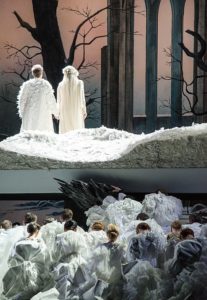
“Lohengrin” is a German opera in three acts, composed and written by Richard Wagner. It was first performed in 1850 in Weimar and is based on a medieval German legend. The opera is considered one of Wagner’s masterpieces and is known for its sweeping orchestrations, soaring melodies, and powerful vocal performances.
The opera tells the story of Lohengrin, a Knight of the Holy Grail, who comes to the aid of a mysterious woman, Elsa, who is accused of murder. Lohengrin agrees to defend her in a trial by combat, but on the condition that she never asks him his name or origin. The opera explores themes of chivalry, loyalty, and the dangers of curiosity and betrayal.
Wagner’s music for “Lohengrin” is characterized by his unique harmonic language and innovative use of leitmotifs, which are recurring musical themes associated with specific characters, objects, or ideas. The opera also features elaborate orchestrations and choral writing, as well as some of Wagner’s most famous and recognizable melodies.
One of the most notable leitmotifs in “Lohengrin” is the “Grail” motif, which is associated with the Holy Grail, the chalice that Lohengrin and his knights are sworn to protect. This motif is introduced in the prelude to the opera and is heard throughout the work, underscoring the importance of the Grail in the story and adding to the mystical and spiritual aspects of the opera.
Another important leitmotif in “Lohengrin” is the “Swan” motif, which is associated with the character of Lohengrin. The motif is first heard as Lohengrin arrives on a swan, and it is used to represent his character and his presence throughout the opera.
Wagner also uses the music in “Lohengrin” to create a sense of emotional intensity and drama. The opera is known for its sweeping orchestrations, soaring melodies, and powerful vocal performances, which combine to create an immersive and emotional experience for the audience.
“Lohengrin” is not the last of Wagner’s romantic operas. While it is considered one of Wagner’s early masterpieces, he went on to compose several other romantic operas after “Lohengrin.” Some of his other notable romantic operas include “Tristan und Isolde” (1865), “Die Meistersinger von Nürnberg” (1868), and “Parsifal” (1882). These later works, like “Lohengrin,” are characterized by Wagner’s sweeping orchestrations, soaring melodies, and intense emotional expression.
“Lohengrin” was a turning point in Wagner’s career and marked the beginning of his mature creative period. It established him as a major force in the world of opera and laid the foundation for his later works, such as “Tristan und Isolde” and “The Ring Cycle.” Wagner’s romantic operas, along with his revolutionary ideas about musical drama and his innovative use of leitmotifs, established him as one of the most important and influential composers of the 19th century. He broke with the traditional forms of opera and sought to create a new form of musical drama that would fully integrate music, drama, and stage design. His romantic operas continue to be performed and admired today for their powerful emotional impact and enduring musical and dramatic qualities.
View our collection of Lohengrin texts at https://www.ipasource.com/catalog/?search=lohengrin&type=all
- Atmest du nicht mit mir die süßen Düfte by Wagner, Richard
- Den dort im Glanz by Wagner, Richard
- Des Königs Wort und Will’ by Wagner, Richard
- Du Ärmste kannst wohl nie ermessen by Wagner, Richard
- Einsam in trüben Tagen by Wagner, Richard
- Entweihte Götter! by Wagner, Richard
- Euch Lüften, die mein Klagen by Wagner, Richard
- Höchstes Vertraun hast du mir by Wagner, Richard
- In fernem Land by Wagner, Richard
- Mein Herr und Gott, nun ruf’ ich dich by Wagner, Richard
- Mein lieber Schwan! by Wagner, Richard
- Nun sei bedankt, mein lieber Schwan! by Wagner, Richard
[Image Lohengrin, Oper Oslo by Francisco Peralta Torrejón via Wikimedia Commons https://commons.wikimedia.org/wiki/File:Lohengrin_8420-Peralta.jpg ]
